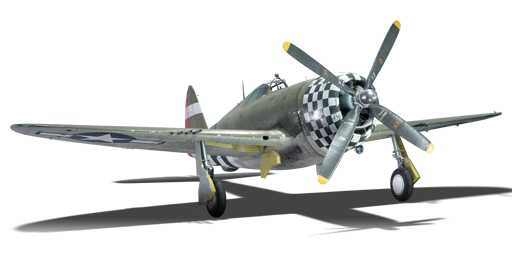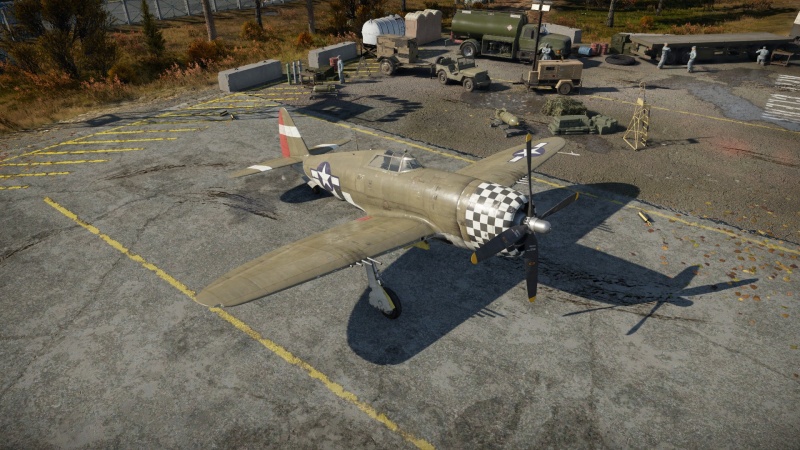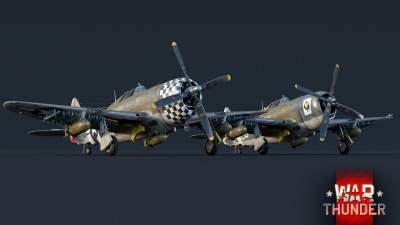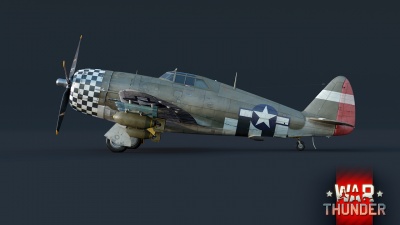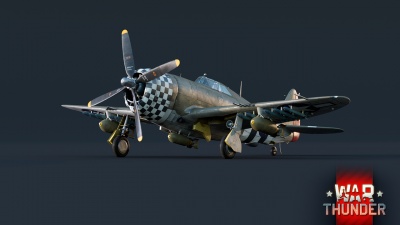Difference between revisions of "P-47D-22-RE"
m (→External links) |
(→Usage in battles) (Tag: Visual edit) |
||
| Line 115: | Line 115: | ||
'''Simulator / EC''' | '''Simulator / EC''' | ||
| − | In Simulator | + | In air Simulator mode, the P-47D-22 RE does not feel as struggling as in RB since simulator is more about situational awareness rather than who climbs the highest in 2 minutes. Its sufficient speed, robust airframe, punching .50 cals and multiple additional options of bombs make it an excellent multi-role aircraft. However, comparing to the later Jugs with all-clear bubble canopy, the razorback P-47 has worse visibility. The front have quite some frames around the gunsight, but they are thin which is a good news. The sides are overall unaffected. The rear view, however, is greatly obstructed by the razorback, preventing the pilot from seeing what's on the tail which can be fatal sometimes. The early P-47 has the same heay weight and large size but the engine is not as powerful as the later models, so it will feel more sluggish at lower speeds. |
| − | The P-47 can perform | + | The P-47 can perform ground attack, bomber intercepting and traditional BnZ fighting. Sim is different from realistic, so discard the habit of bringing the least fuel. Bring at least 30 minutes of fuel, although it decreases the plane's performance a bit, it prevents constant refueling which saves time for patrolling and fighting. |
| − | For | + | For takeoff, while your P-47 accelerates down the runway, dip the nose parallel to the ground to decrease drag. You can use no flaps at all until the speed is above 200 km/h since heavier planes generally need more speed to lift off. This is especially more true if your Jug is carrying a full bombload. As you are fast enough, deploy combat/takeoff flaps, and gently pull the stick back, the P-47 will get airborn easily. The retract landing gears, and flaps once you are above ~220 km/h unloaded, or ~260 km/h with bombs. Be careful when maneuvering with a full bombload, an aircraft this heavy will lose quite some altitude when rolling so watch your altitude if you just took off and is still near the ground. |
| − | For ground pounding, | + | For ground pounding, use the bombs to take out pillboxes and tanks, and the MG for trucks, AAA, and howitzers. Be around 750m above the ground so you have enough room to dive at the target and gather enough momentum for the bombs, making them land nearer to where you aim at. Try to drop as close to the target as possible but do not crash. An ideal dive speed before releasing palyload is around 500 km/h. When the gunsight slices through and above the target, drop the 1000 lbs. When the target is just above the center of the gunsight and fills up around half of it, release the 500 lb. The 8 MGs are perfect for killing trucks, AA guns and artilleries as they have plenty of ammo and good damage. However, always watch your surrounding, especially your high 6 for any incoming enemies. Constantly pumping killfeeds onto the opponents' screens will sure alert some of them to look for you. |
| − | + | Due to the rather inadequate climb rate of the P-47D-22 RE, it may be a good option to hunt down low-altitude ground pounders rather than climbing to a bomber's altitude, especially if your airfield is close to the frontline leaving you little room/time to climb. Wander around friendly ground units like tank/truck columns, AAA/howitzer fields and bunkers, they are very likely to attract enemy ground pounders. Remain at an altitude of ~1200m until you see a target. You can start diving at it straight away, or if you can get the timing correctly, dive right when the ground pounder finishes a pass and is climbing up for the next pass, this is when it is the slowest and most unresponsive. Also because of the positions (prey is almost perpendicular in front of the attacker) the target's large cross section of the entire top will be presented to the guns. For a diving P-47, that is pretty much setting oneself up as an easy, large and motionless target. Lead carefully and put a solid burst into it, usually it will get crippled if not destroyed straight away. | |
| − | As for dogfighting, because almost all aerial battles in Sim occurs at below 3,000 m, the P-47 can easily climb to this altitude and gather up lots of speed before engaging a battle. The tactic is similar to | + | As for dogfighting, because almost all aerial battles in Sim occurs at below 3,000 m, the P-47 can easily climb to this altitude and gather up lots of speed before engaging a battle. The tactic is similar to everyday RB tactics, that is to utilise your speed, powerful guns, and altitude if you have any. If, unfortunately, you find yourself being chased at your 6 and you don't know how to do any defensive manoeuvres, do a large, smooth turn towards the nearest friendly airfield to avoid bleeding too much speed. Then shallow-dive towards your airfield. The P-47 can quite easily outrun opponents like the A6M or Bf-109 E, but struggles to outrun Bf-109 F/G, FW-190 A or other P-47. Another way of disengaging is to do a sudden split-S to dodge under the chaser. Average Sim players will now try and see where you went, if not immediately losing track of you. You can then run for your airfield or shallow climb for another attack. |
'''Enemies worth noting:''' | '''Enemies worth noting:''' | ||
Revision as of 10:26, 1 February 2021
Contents
Description
The P-47D-22-RE Thunderbolt is a rank III American fighter with a battle rating of 4.0 (AB) and 3.7 (RB/SB). It was introduced in Update "Raining Fire".
General info
Flight performance
In Arcade battles, the P-47 can be pushed to its limits. Climb rate, turn rate, and responsiveness are all dramatically increased. Still, tactics used in RB also apply very well in Arcade- this fighter is great for practising Boom & Zoom in Arcade due to the impressive climb rate in this mode. However, the skill will not be built nearly as well in this mode, as rolling scissors and "skidding" manoeuvres will not really be needed.
Overall, the P-47 is a very pleasurable plane to fly for a quick jaunt in arcade battles.
| Characteristics | Max Speed (km/h at 9,144 m) |
Max altitude (metres) |
Turn time (seconds) |
Rate of climb (metres/second) |
Take-off run (metres) | |||
|---|---|---|---|---|---|---|---|---|
| AB | RB | AB | RB | AB | RB | |||
| Stock | 665 | 654 | 12200 | 26.2 | 27.1 | 6.5 | 6.5 | 600 |
| Upgraded | 719 | 695 | 23.8 | 25.0 | 14.6 | 10.0 | ||
Details
| Features | ||||
|---|---|---|---|---|
| Combat flaps | Take-off flaps | Landing flaps | Air brakes | Arrestor gear |
| ✓ | ✓ | ✓ | X | X |
| Limits | ||||||
|---|---|---|---|---|---|---|
| Wings (km/h) | Gear (km/h) | Flaps (km/h) | Max Static G | |||
| Combat | Take-off | Landing | + | - | ||
| 0 | 450 | 520 | 520 | 320 | ~13 | ~6 |
| Optimal velocities (km/h) | |||
|---|---|---|---|
| Ailerons | Rudder | Elevators | Radiator |
| < 402 | < 420 | < 470 | > 335 |
Survivability and armour
The pilot and fuel tanks have decent armour protection from the front, but the engine is vulnerable from the front. The pilot has no armour protection from the rear, leaving him vulnerable.
- 38 mm Bulletproof Glass - Windshield
- 9.5 mm Steel - Below Windshield
- 9.5 mm Steel - Behind Engine, In Front of Fuel Tanks and Pilot
- Self-Sealing Fuel Tanks
Modifications and economy
Armaments
Offensive armament
The P-47D-22-RE is armed with:
- 8 x 12.7 mm M2 Browning machine guns, wing-mounted (425 rpg = 3,400 total)
Suspended armament
The P-47D-22-RE can be outfitted with the following ordnance:
- Without load
- 1 x 500 lb AN-M64A1 bomb (500 lb total)
- 2 x 1,000 lb AN-M65A1 bombs (2,000 lb total)
- 2 x 1,000 lb AN-M65A1 bombs + 1 x 500 lb AN-M64A1 bomb (2,500 lb total)
- 6 x M8 rockets
- 6 x M8 rockets + 1 x 500 lb AN-M64A1 bomb (500 lb total)
Usage in battles
Simulator / EC
In air Simulator mode, the P-47D-22 RE does not feel as struggling as in RB since simulator is more about situational awareness rather than who climbs the highest in 2 minutes. Its sufficient speed, robust airframe, punching .50 cals and multiple additional options of bombs make it an excellent multi-role aircraft. However, comparing to the later Jugs with all-clear bubble canopy, the razorback P-47 has worse visibility. The front have quite some frames around the gunsight, but they are thin which is a good news. The sides are overall unaffected. The rear view, however, is greatly obstructed by the razorback, preventing the pilot from seeing what's on the tail which can be fatal sometimes. The early P-47 has the same heay weight and large size but the engine is not as powerful as the later models, so it will feel more sluggish at lower speeds.
The P-47 can perform ground attack, bomber intercepting and traditional BnZ fighting. Sim is different from realistic, so discard the habit of bringing the least fuel. Bring at least 30 minutes of fuel, although it decreases the plane's performance a bit, it prevents constant refueling which saves time for patrolling and fighting.
For takeoff, while your P-47 accelerates down the runway, dip the nose parallel to the ground to decrease drag. You can use no flaps at all until the speed is above 200 km/h since heavier planes generally need more speed to lift off. This is especially more true if your Jug is carrying a full bombload. As you are fast enough, deploy combat/takeoff flaps, and gently pull the stick back, the P-47 will get airborn easily. The retract landing gears, and flaps once you are above ~220 km/h unloaded, or ~260 km/h with bombs. Be careful when maneuvering with a full bombload, an aircraft this heavy will lose quite some altitude when rolling so watch your altitude if you just took off and is still near the ground.
For ground pounding, use the bombs to take out pillboxes and tanks, and the MG for trucks, AAA, and howitzers. Be around 750m above the ground so you have enough room to dive at the target and gather enough momentum for the bombs, making them land nearer to where you aim at. Try to drop as close to the target as possible but do not crash. An ideal dive speed before releasing palyload is around 500 km/h. When the gunsight slices through and above the target, drop the 1000 lbs. When the target is just above the center of the gunsight and fills up around half of it, release the 500 lb. The 8 MGs are perfect for killing trucks, AA guns and artilleries as they have plenty of ammo and good damage. However, always watch your surrounding, especially your high 6 for any incoming enemies. Constantly pumping killfeeds onto the opponents' screens will sure alert some of them to look for you.
Due to the rather inadequate climb rate of the P-47D-22 RE, it may be a good option to hunt down low-altitude ground pounders rather than climbing to a bomber's altitude, especially if your airfield is close to the frontline leaving you little room/time to climb. Wander around friendly ground units like tank/truck columns, AAA/howitzer fields and bunkers, they are very likely to attract enemy ground pounders. Remain at an altitude of ~1200m until you see a target. You can start diving at it straight away, or if you can get the timing correctly, dive right when the ground pounder finishes a pass and is climbing up for the next pass, this is when it is the slowest and most unresponsive. Also because of the positions (prey is almost perpendicular in front of the attacker) the target's large cross section of the entire top will be presented to the guns. For a diving P-47, that is pretty much setting oneself up as an easy, large and motionless target. Lead carefully and put a solid burst into it, usually it will get crippled if not destroyed straight away.
As for dogfighting, because almost all aerial battles in Sim occurs at below 3,000 m, the P-47 can easily climb to this altitude and gather up lots of speed before engaging a battle. The tactic is similar to everyday RB tactics, that is to utilise your speed, powerful guns, and altitude if you have any. If, unfortunately, you find yourself being chased at your 6 and you don't know how to do any defensive manoeuvres, do a large, smooth turn towards the nearest friendly airfield to avoid bleeding too much speed. Then shallow-dive towards your airfield. The P-47 can quite easily outrun opponents like the A6M or Bf-109 E, but struggles to outrun Bf-109 F/G, FW-190 A or other P-47. Another way of disengaging is to do a sudden split-S to dodge under the chaser. Average Sim players will now try and see where you went, if not immediately losing track of you. You can then run for your airfield or shallow climb for another attack.
Enemies worth noting:
- Me 264: This giant is one of the few bombers who get air spawns in Sim, so it usually flies higher than many would think. On top of this, the Me 264 is armed with large calibre MG and cannons all over it, therefore tailing a 264 is basically suicide unless all of their gunners are knocked out. Treat the 264 almost like a B-29 or B-17 as they are very similar in both design and defensive capabilities. It is best to head-on the 264 if possible to easily knock out the pilots due to its glazed nose while also taking minimal damage. However the bomber lacks a ventral turret on its belly, making it easy to deal damage from below, but be weary of the downwards facing rear 20 mm cannon near the tail. The safest way to attack is from a higher altitude, dive at an oblique angle and focus fire on the wings and nose. Never engage if the P-47 has no altitude advantage.
- Bf 110, Ki-45, A-26: As mentioned before, those twin engine aircraft are a big threat since their lack of manoeuvrability comparing to single engine fighters are minimised in Sim. They are usually armed with heavy guns & cannons in the nose, so an accurate burst will tear any plane apart, including the P-47. The P-47 manoeuvres rather sluggishly and the plane might get out-turned from even those heavy fighters, so engage them with either altitude or speed advantage to avoid being targeted. If they are not manoeuvring aggressively, aim for their wings or engines. If the fight is intense and the P-47D-22-RE pilot cannot smooth the aim, just burst anywhere as long as the guns hit them, the 12.7 mm bullets will damage their flight models quite a bit.
- Yak-2 KABB: Do not think that the P-47D-22-RE can confidently out maneuver this plane just because it is twin-engined. The Yak-2 has an amazing turn rate for a heavy fighter, thus the P-47D-22-RE must avoid turning with it, if not dogfighting with it in general. It bears a pair of ShVAK cannons that can easily damage vital parts like engine or cooling systems. It has green camo, greatly resembling an Me 410 but with an H-tail like a Bf 110's.
- ZSD63: A dangerous SPAA to go up against in Tank Realistic Battles. Though it is hard to identify specific SPAA vehicles on the ground (especially when they are shooting tracers at the plane), if a ZSD63 is identified, avoid it at all costs and do not attempt head-ons with it, ever. It can easily snap a wing off by casually putting a short burst in the P-47D-22-RE's flight path. Don't even get close to it unless it is busy shooting someone else or if the P-47D-22-RE has a bomb ready for use. Some identifying features of the ZSD63 is its rather boxy and tall hull with a geometric turret sitting at the back, slightly similar to a Wirbelwind's. The firing manner is also distinctive: the sound and green tracers are very rapid, much like a buzz saw, but then it will remain silent for half a minute reloading. Note that an experienced ZSD player will hold its fire or shoot in single salvos with long halts between, making it look like that it's reloading. Armor piercing belt is recommended since their high penetration can tear through the ZSD's armor with ease and knock out its crews.
Manual Engine Control
| MEC elements | ||||||
|---|---|---|---|---|---|---|
| Mixer | Pitch | Radiator | Supercharger | Turbocharger | ||
| Oil | Water | Type | ||||
| Controllable | Controllable Auto control available |
Controllable Not auto controlled |
Controllable Not auto controlled |
Separate | Controllable 1 gear |
Auto controlled |
Pros and cons
Pros:
- Great bomber destroyer against a lone bomber
- Excellent high altitude performance
- If taken care of, can easily fly with one wing
- Muscle car with wings, excellent at Boom and Zoom tactics
- 8 M2 Browning machine guns are accurate at a longer range than most cannons at its BR
- High speed, even while stock
- Very durable which semi-compensates with its lacklustre turn rate
- Plenty of ammo
- Can easily escape enemies with its high speed for its rank
- Great multirole aircraft, can carry various bombs and rockets, acting as an interceptor or ground-attack aircraft
Cons:
- Frontal armour can easily be penetrated by 20 mm rounds
- Can easily snap a wing when even the slightest gunfire hits it
- Poor stall characteristics
- Mediocre climb performance (side climbing recommended)
- Slow and hard to manoeuvre at low altitudes
- Larger than average fighter
- Poor overall performance when mounting payloads
- After attacking ground targets, the P-47 lacks the altitude to Boom & Zoom enemy fighters
- Big engine easily hit during a head-on attack
- Worse cockpit visibility than in the other bubble canopy P-47s
- No armour protection for pilot from behind
History
Describe the history of the creation and combat usage of the aircraft in more detail than in the introduction. If the historical reference turns out to be too long, take it to a separate article, taking a link to the article about the vehicle and adding a block "/History" (example: https://wiki.warthunder.com/(Vehicle-name)/History) and add a link to it here using the main template. Be sure to reference text and sources by using <ref></ref>, as well as adding them at the end of the article with <references />. This section may also include the vehicle's dev blog entry (if applicable) and the in-game encyclopedia description (under === In-game description ===, also if applicable).
Media
- P-47D-22-RE Devblog Images
See also
Links to the articles on the War Thunder Wiki that you think will be useful for the reader, for example:
- reference to the series of the aircraft;
- links to approximate analogues of other nations and research trees.
External links
| Republic Aviation Corporation | |
|---|---|
| Fighters | P-43A-1 |
| P-47D-22-RE · P-47D-25 · P-47D-28 · P-47M-1-RE · ⋠P-47M-1-RE · P-47N-15 | |
| Jet Aircraft | F-84B-26 · F-84F · F-84G-21-RE |
| F-105D | |
| Export | J9 Early* |
| ␗P-43A-1 | |
| ▄Thunderbolt Mk.1 · ▄P-47D-22-RE · ␗P-47D-23-RA · ▂P-47D-27 · ␗P-47D-30 · ▄P-47D-30 · ␗F-47N-25-RE | |
| ◄F-84F · ▄F-84F (Italy) · ▄F-84F (France) · F-84F IAF · F-84F | |
| ␗F-84G-21-RE · ▄F-84G-21-RE · ▄F-84G-26-RE · ␗F-84G-31-RE | |
| Captured | ▀P-47D-16-RE · ▀P-47D |
| *The company was named "Seversky Aircraft Company" before being renamed in 1939 | |
| USA fighters | |
|---|---|
| P-26 Peashooter | P-26A-33 · P-26A-34 · P-26A-34 M2 · P-26B-35 |
| P-36 Hawk | P-36A · Rasmussen's P-36A · P-36C · ○P-36C · P-36G |
| P-39 Airacobra | P-400 · P-39N-0 · P-39Q-5 |
| P-40 | P-40C · P-40E-1 · P-40E-1 TD · P-40F-10 |
| P-43 Lancer | P-43A-1 |
| P-47 Thunderbolt | P-47D-22-RE · P-47D-25 · P-47D-28 · P-47M-1-RE · ⋠P-47M-1-RE · P-47N-15 |
| P-51 Mustang | P-51 · P-51A (Thunder League) · P-51C-10 · P-51D-5 · P-51D-10 · P-51D-20-NA · P-51D-30 · P-51H-5-NA |
| P-63 Kingcobra | P-63A-5 · P-63A-10 · P-63C-5 · ␠Kingcobra |
| Prototypes | XP-55 |
| F2A Buffalo | F2A-1 · Thach's F2A-1 · F2A-3 |
| BF2C | BF2C-1 |
| F3F | F3F-2 · Galer's F3F-2 |
| F4F Wildcat | F4F-3 · F4F-4 |
| F4U Corsair | F4U-1A · F4U-1A (USMC) · F4U-1D · F4U-1C · F4U-4 · F4U-4B · F4U-4B VMF-214 · F2G-1 |
| F6F Hellcat | F6F-5 · F6F-5N |
| F8F Bearcat | F8F-1 · F8F-1B |
| Other countries | ▃Ki-43-II · ▃Ki-61-Ib · ▃A6M2 · ▃Bf 109 F-4 · ▃Fw 190 A-8 · ▃Spitfire LF Mk IXc |


